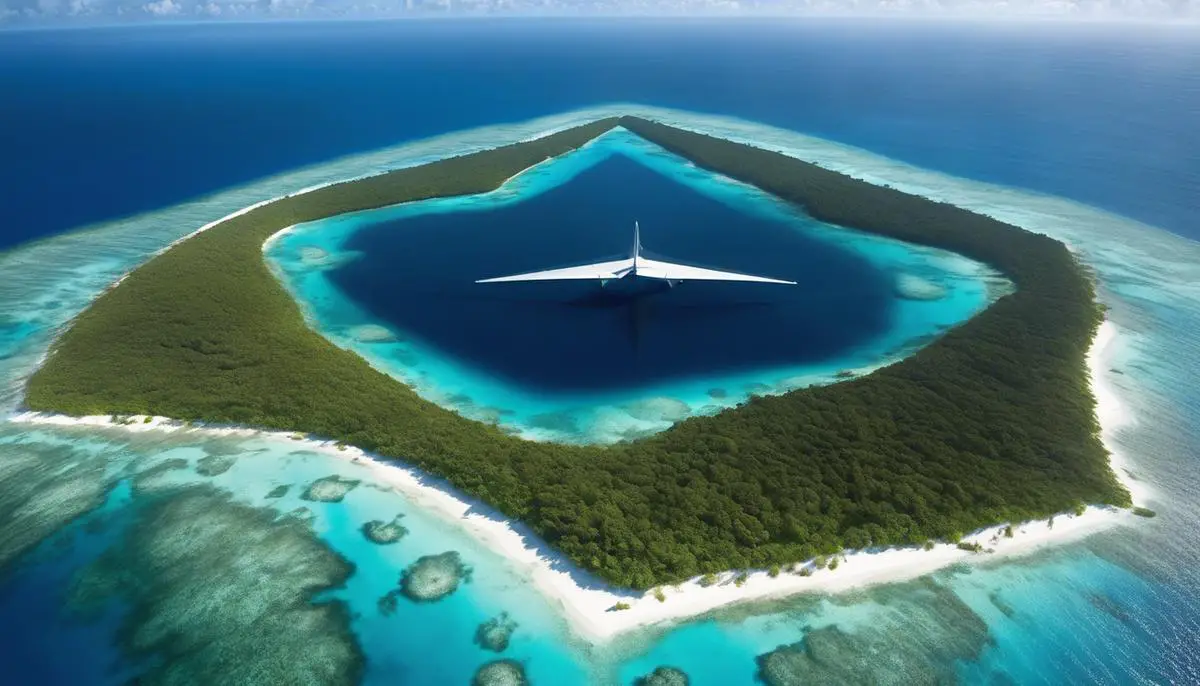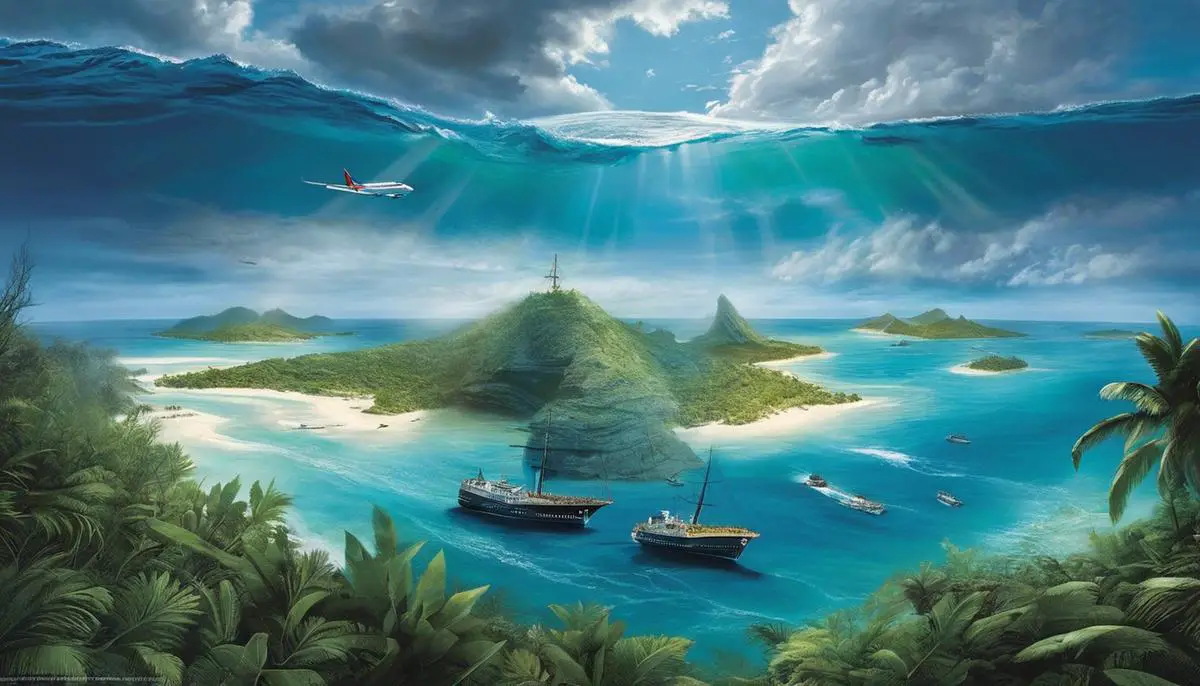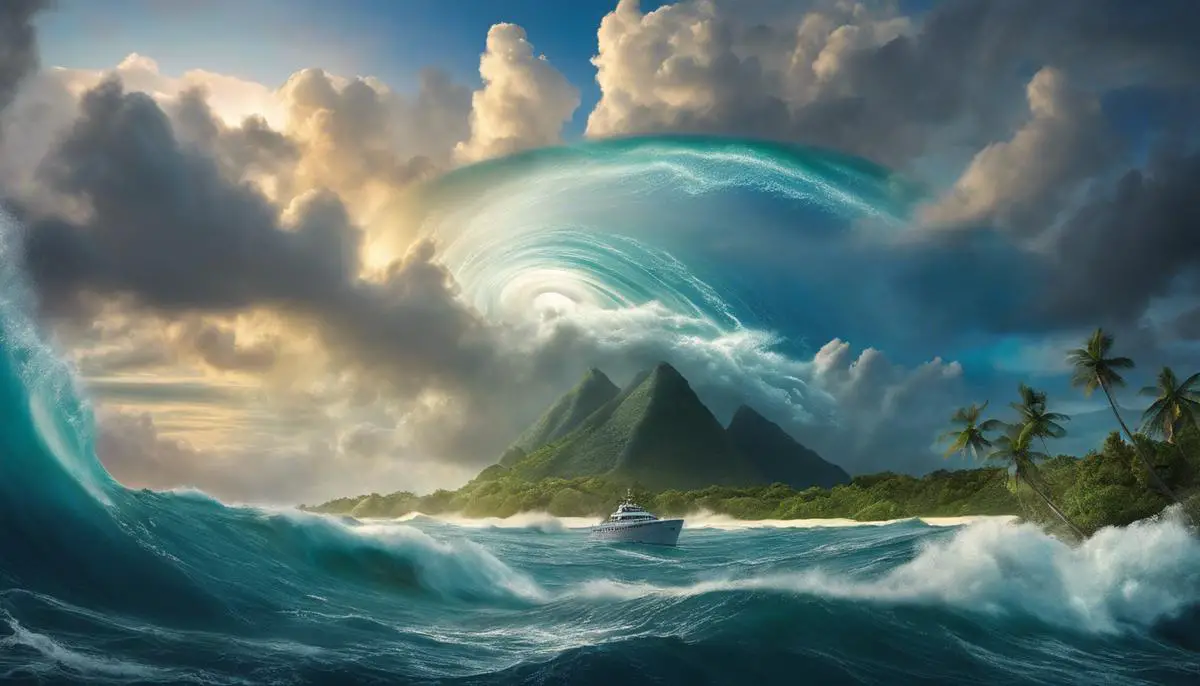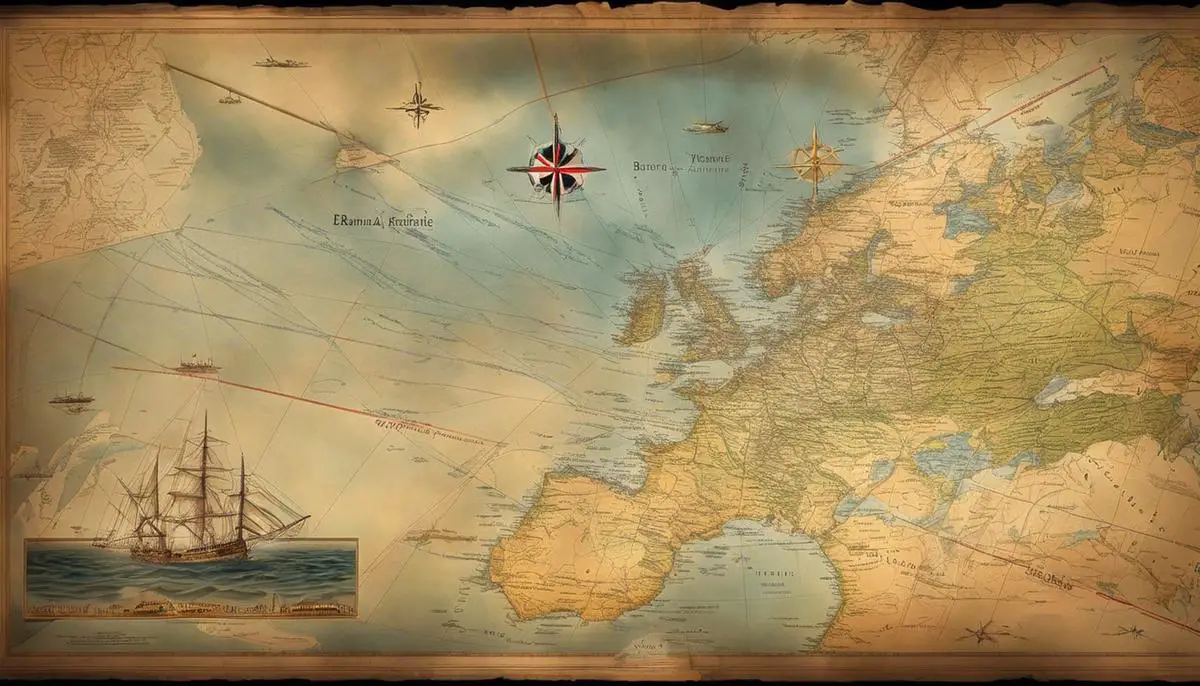Positioned in the western part of the North Atlantic Ocean, the Bermuda Triangle has long captured the collective imagination of people across the globe with its tales of unexplained disappearances and peculiar phenomena. The scope of its boundaries, punctuated by Miami, Puerto Rico, and Bermuda, are home to a vast array of oceanic and atmospheric oddities that have created an enduring aura of mystery around this area. Over the years, countless ships and aircraft have reportedly vanished without a trace within this region, adding fuel to the enigma. This intrigue has not only permeated our popular culture, with references scattered across various forms of media, but has also driven scientists to unravel its mysteries with various theories and explanations.
Geographical Profile and Historical Accounts of the Bermuda Triangle
The Bermuda Triangle
The Bermuda Triangle, a term coined in 1964, refers to a region of the North Atlantic Ocean that forms an invisible triangle between Miami, Florida; Bermuda; and San Juan, Puerto Rico. These points, when connected, give the triangle its approximation of 500,000 square miles. This expanse includes international waters and parts of several nations’ maritime zones.
Its geographical scope, however, is not the source of its fame. It is the Bermuda Triangle’s eerie history that truly fascinates. Throughout the years, a series of unexplained events have unfolded in this region. Maritime and aviation incidents ranging from simple mechanical failures to inexplicable vessel disappearances have led to theories and speculations that create the Triangle’s mysterious allure.
The mysteries commenced in 1945 with the infamous Flight 19 incident, where five US Navy aircraft disappeared without a trace during a routine training mission. Despite extensive search operations, neither wreckage nor bodies were ever recovered. This event marked the beginning of the Triangle’s association with unexplained disappearances.
In subsequent years, the Triangle continued to be a scene of numerous anomalies. The SS Marine Sulphur Queen, a large carrier ship, vanished in 1963 along with its 39 crew members in the Triangle’s expansive waters. Again, no wreckage or debris was found, adding another layer to the enigmatic narrative of this region.
Unsettling incidents within the Triangle are not confined to the past. In recent years, private yachts, cargo ships, and even commercial planes have been lost, with the wreckage rarely recovered. Such cases have occasionally led to thorough investigations which, having ruled out conventional explanations, have only served to deepen the mystery.
In terms of physical effects within the Triangle, unusual climatic events and oceanic phenomena have also been observed. Compass and navigation anomalies, sudden weather changes, and random pockets of turbulent sea are a few examples. While some attribute these effects to natural causes like methane hydrates, Gulf Stream, or human error, others link them to the region’s paranormal reputation.
Scientifically speaking, there is no established correlation between Triangle’s geography and these uncanny incidents. Also, from a statistic perspective, the frequency of maritime and aviation accidents in this region is not significantly higher than in any other heavily-trafficked region of the world. Yet, the Bermuda Triangle’s enduring mystery lies in how several incidents have seemingly defied logical explanation.
Concise understanding of the Triangle is limited due to its complex nature and the vast array of incidents it encompasses. The geographical scope, combined with the enigmatic history, creates a mystique that intrigues researchers, scientists, and everyone interested in unsolved phenomena. As long as the Bermuda Triangle continues to harbor such mysteries, its allure within popular and scientific culture will remain undiminished.

Scientific Theories and Explanations for the Bermuda Triangle Phenomena
Unlocking the Enigma of the Bermuda Triangle: Scientific Explorations and Conclusions
Our human instinct to illuminate the obscure corners of our knowledge renders mysteries like the Bermuda Triangle irresistible to researchers and scientists. While the Triangle’s enigma has been magnified by tales of lost aircraft and ships, explanation attempts have not been wanting. Predominantly, these endeavors have focused on meteorological, geological, and human errors, debunking many sensationalized, unsubstantiated claims.
One widely examined hypothesis pivots on the triangle’s unique weather. This area frequently experiences rapid, intense storms, which, given the right conditions, could ostensibly disrupt maritime or aerial navigations. Microbursts, a type of storm featuring a sudden, powerful downdraft of wind, are likely culprits. These could generate formidable waves in open water, quickly exceeding a ship’s buoyancy threshold or causing an aircraft’s fatal crash dive. Lightning and waterspouts, also common in this region, pose additional risks.
The marine and aviation history within the triangle does exhibit instances aligning with adverse weather conditions, validating this theory partially. However, not all incidents correspond to poor weather, thus directing researchers towards other avenues of investigation.
Another potential explanation involves methane hydrates on the seafloor. Under certain conditions, these methane fields can destabilize, releasing considerable gas quantities to the surface. The up-surging methane decreases water density, increasing the sink risk for ships. For planes, methane can disrupt engine functionality, potentially indicating an abrupt loss of power and subsequent disappearance. Given the seafloor’s complicated topography within the Bermuda Triangle, the methane hypothesis cannot be entirely dismissed.
Significantly, research has highlighted human error and malfunctioning equipment as plausible factors. Even seasoned sailors, and aviators can become disoriented in the Triangle’s extensive, featureless expanse. Misreading equipment, mistaking illusions like false horizons or optical illusions generated by atmospheric conditions, or underestimating storm intensity might have led to many disasters.
Furthermore, the requisite comprehensive scrutiny of the equipment involved in disappearances is often unattainable. Ill-maintenance, technical malfunction, or operational mistakes seldom leave traceable clues after a catastrophic incident at sea or in the air. However, historical analysis of comparable incidents globally suggests that these mechanical and human factors likely contribute significantly to the Bermuda Triangle’s unsolved mysteries.
The science-oriented assessment of the Bermuda Triangle has continually deflated many a myth, introducing logic and understanding into an area frequently shrouded in superstition and sensationalism. While the unpredictability of nature and the fallibility of humans remain integral aspects in these discussions, the scientific community’s work has shifted the narrative from inexplicable disappearances towards traceable, albeit unfortunate, incidents.

Psychology and Popular Culture References to the Bermuda Triangle
Shifting the narrative now to popular culture, it is undeniable the influence the Bermuda Triangle has had, serving frequently as the mysterious and dangerous setting for various novels, films, and television shows. It has become an established trope within the horror and thriller genres, capitalizing on the sense of trepidation and intrigue elicited by the Triangle’s enduring enigma.
One of the earliest examples comes in 1977, when Steven Spielberg employed the Bermuda Triangle in his film, “Close Encounters of the Third Kind”. The story hinges greatly on the aforementioned Flight 19 incident, toying with the idea of alien intervention as an explanation. Several other cinematic constructs, like “The Bermuda Triangle” (1978) and the later “Bermuda Tentacles” (2014), have similarly employed the region as a backdrop for the supernatural or the extraterrestrial.
In literature as well, countless books have taken up the Bermuda Triangle as a subject for exploration. Perhaps most famous among these is Charles Berlitz’s 1974 book, “The Bermuda Triangle”, which posits many inventive theories, including the existence of an advanced lost civilization or alien involvement in the disappearances. The mystery inherent in the Bermuda Triangle narrative lends itself naturally to the speculative fiction genre.
The reach of the Bermuda Triangle extends into video games, music, and even comic books. Seminal franchises like “Tomb Raider” and “Scooby-Doo” have used the concept as a plot device, further engraving the enigma of the Triangle into global consciousness. The power of the Bermuda Triangle as a cultural entity thrives on its inherent capacity to spark the human imagination and fascination with the unknown.
This saturation in popular culture leads us to the psychological impact of the Bermuda Triangle on public perception. The inherent human attraction to mystery, coupled with the media’s role in amplifying the Triangle’s reputation, has sustained the public’s fascination over the decades. The Bermuda Triangle becomes a canvas upon which fears, desires, and fantasies are projected and manifested in various forms.
From a psychological perspective, mystery breeds curiosity, and fear acts as an incentive for exploration and knowledge. In the case of the Bermuda Triangle, the mystery engenders a wide array of emotional responses – fear, curiosity, and fascination being prominent among them. This intense engagement with the phenomenon spurs further enquiry and stimulates discourse, continually feeding the cycle and ensuring the Triangle’s enduring popularity.
While the Bermuda Triangle’s mysteries continue to confound scientists and skeptics alike, its indelible mark on popular culture and the human psyche attests to its significance beyond the realms of geography and maritime history. Given the diligent pursuit of understanding, perhaps one day, the shroud will be lifted, and the Bermuda Triangle will be another navigational area steeped in a rich history of exploration and enlightenment. Until then, the Triangle’s influence persists, in popular culture and public perception alike, more powerful than any oceanic current or ill-fated flight.

The Bermuda Triangle, with its numerous unsolved mysteries and curious phenomena, continues to command a firm hold on our collective conscious and will likely continue to spark imaginations for the foreseeable future. The unanswered questions and unsolved mysteries of this maritime ghost town have created an enigma that has inspired countless scientific research works, enveloped influence over our psyches, and owned a prominent position in our popular culture. As we wade through its dark waters of mystery, one can’t help but confront the stark reality that, despite our technological advancements and continued research efforts, the Bermuda Triangle remains an unsolved riddle of our world, and its enigma continues to fascinate and unsettle our consciousness.
![]()
